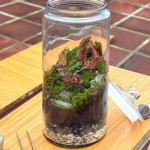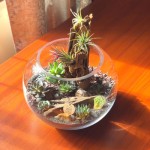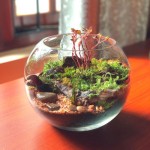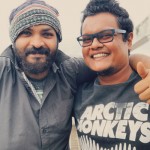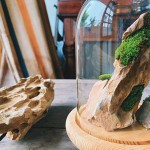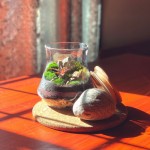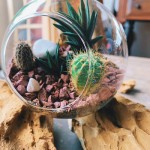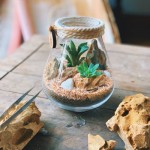Wonders of nature in a glass container
With travel plans shelved for the distant future, it’s no wonder a lot of us have been feeling restless and drained of creative energy. But what if you had a world to explore, right there at your fingertips? The answer seems to lie within a glass container.
‘Petrikor’ is the passion project of Rommel Arumugam and Gadheesha Fernando, two friends who wanted to create something that encapsulated the wonders of the natural world and helped people understand the importance of nature. And what better way than through a terrarium?
- Rommel Arumugam and Gadheesha Fernando
- A little bit of outdoors indoors: Terrariums in all shapes and sizes
Gadheesha has always been happy outdoors and today he is the resident green thumb and voice of the brand. For Rommel, an Art Director and Designer by trade, it was the “new frontier of being able to create art with organic matter” that drew him in, and the intent of shaping and taking care of it that added that second layer of excitement.
Rommel is the visual expert, and the driving force for the growth of the brand. Together, they share the same duties such as collecting and propagating moss and flora, finding suppliers for containers, working out soil composition, delivery, and of course terrarium design.
The name Petrikor was inspired by what the insides of the terrariums smell like: a rainy day. The word ‘petrichor’ is defined by the Greek as the ‘earthy scent produced when rain falls on dry soil’ — one that they felt was a perfect representation of their friendship and shared love of the earth.
“Preserving nature and informing the people of its value is of course our mission,” Gadheesha says, and this ethos is what guides the pair on their occasional expeditions in search of inspiration for the terrariums. Many of these adventures would be to the misty mountain tracks of Haputale and Nuwara Eliya, amongst others.
“Imagine trekking for hours only to stumble upon the most beautiful creek you have ever seen. The sounds of the world left far behind you, howling winds guide your way, and a forgotten path once used by the wandering local. When you are lost in paradise, time is irrelevant,” they share.
The pair also have had their fair share of painful experiences on their treks. Gadheesha recalls looking at a clump of moss on a steep mountain slope, only to find several tiny spiders biting his hands.
Despite the challenges however, business has looked up for them. Though they admit it was a little scary in the beginning since they did not have the ability to produce more than one or two terrariums a week, they have now refined their process and “are ready for the rising winds.”
Each terrarium begins with the creation of a water reservoir. From there, the process begins to differ as the soil composition in each terrarium depends on the type and the nutrient requirements of the flora. But whether it’s a lush ecosystem bursting with plant life or low nutrient plants like succulents, visual narrative is key when composing their terrariums. Following “the rule of thirds”, they position their centrepieces to guide the viewer’s eye.
Some of the larger terrariums may even feature some interesting macrofauna, in the form of Isopods and Springtails. These helpful little critters are crustaceans (not insects) that keep the terrariums clean by consuming any fungal spores and other pests. “With people, isopods are like Marmite, either they love ’em or they hate ’em. We think they are cute, and that every isopod or springtail deserves to be happy,” Gadheesha tells us.
Petrikor offers three types of terrariums, the aesthetically-pleasing Grove type terrarium that resembles Zen and designer gardens, their Primal type that encapsulates the wilderness of the forest and mountains, and lastly the Arid type consisting of desert flora.
“We do occasionally create terrariums that do not fit into either category. We like to call them ‘aesthetic experiments’,” Gadheesha explains. They would draw inspiration from their surroundings, from river beds and mountain faces to marshlands and mangrove beachfronts. Sometimes they let their own interests and influences drive them, such as their love for storytelling and the sci-fi and fantasy genres. Or simply go with the flow. “The final product is often a surprise, but that is part of the reason we love it.”
Since terrariums are closed ecosystems, all of their needs except for sunlight are self-sustained. To look after it, one would simply have to keep it in a naturally lit space, though not in direct sunlight as the glass amplifies heat. Water may be added occasionally when the terrarium needs to be maintained or defogged. For non-succulent terrariums, the best indicator of watering it is when the surface soil appears dry. Looking after the terrariums is easy, even for “accidental plant-murderers”, if one follows the instructions that they provide.
“We build them to last, and we build them with love,” they tell us.
Both Gadheesha and Rommel deeply appreciate Sri Lanka’s beauty, its cold misty mountains, lush forests and sandy beaches — and this is exactly why they see a greater need to preserve it. Nature lovers themselves, they are delighted when people share in their passion for the tiny worlds they offer. And with a little push from Petrikor, they hope this love for green turns from a spark to a flame.
These hand-built terrariums come in different shapes and sizes, with medium sized terrariums starting at Rs. 3000 to Rs. 6000, larger ones from around Rs. 6000 to Rs. 12,000, and giant ones around Rs.15,000.
The duo can be contacted via their Instagram page @Petri.kor_, or email Petrikorium@gmail.com if you would like them to design your very own terrarium. Petrikor delivers in Colombo, with pickup available from one of their Borella or Nugegoda workshops.



